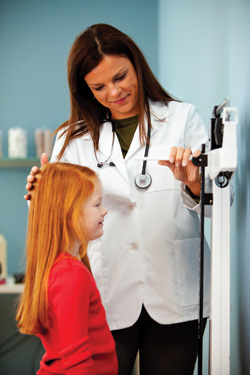
Largest, longest study to uncover keys to healthy development
The largest-ever study of children’s health in the United States, the National Children’s Study (NCS), is enrolling 100,000 children and their families across the country. Physicians and researchers will follow them from before birth until they reach 21, examining the effects of such environmental factors as air, water, diet, sound, family dynamics, community and cultural influences, and genetics on their growth, development, and health.
As the most detailed study in U.S. history focused on children’s health and development, it is comparable to long-term, ongoing studies of adult health, particularly the Framingham Heart Study, begun in 1948, and the Nurses’ Health Study, from 1976. Because of its size, it is statistically valid and will permit generalizations about the nation as a whole, as well as detailed analysis of specific communities and subpopulations.
“We will have more information than ever about how the environment and genetics affect children’s health and their development,” says Yvonne Maddox, Ph.D., Deputy Director, Eunice Kennedy Shriver National Institute of Child Health and Human Development (NICHD). “And that can make a huge impact on the generations to come.” The NICHD is conducting the study with the National Institute of Environmental Health Sciences (NIEHS). Both are part of the National Institutes of Health (NIH).
Study Goal
The goal is to improve the health and well-being of children by increasing understanding of the various factors that may affect health and disease. Results will be made available—and potential benefits publicized—as the research progresses. New insights may be gained into many conditions, including birth defects and pregnancy-related problems; injuries; asthma; obesity; diabetes; and learning, behavior, and mental health disorders.
“The study provides an integrated perspective,” says Steven Hirschfeld, M.D., Ph.D., the study’s acting director and NICHD associate director for clinical research. “No one has tried to bring all these things together in one study to help understand what makes children healthy.” The information will lead to new prevention strategies, and health and safety guidelines, as well as help guide future research.
The study is uniquely data-driven, evidence-based, and community- and participant-informed. At full enrollment, it will operate in 105 locations across the nation. They have been selected to ensure that participants come from diverse ethnic, racial, economic, religious, geographic, and social groups. There are 79 metropolitan areas (urban, suburban, and small cities), as well as 26 rural communities; 37 sites have been participating in the study’s pilot phase to determine the best way to recruit women who are pregnant or expecting to become pregnant.
Says Dr. Hirschfeld, “In the pilot phase, we are working out some of the scale-up procedures before we go into the main study. This is a unique opportunity for women to learn about their families, their communities, and contribute to their children’s health.”
Recruiting
The recruitment strategies include:
- Provider-based: Potential participants are introduced to the study through their healthcare providers, such as a doctor, midwife, or public health nurse, as well as through other community outreach efforts.
- Enhanced Household-based: Participants join through door-to-door enrollment at their homes, as well as other community outreach efforts.
- Two-tiered (High Intensity/Low Intensity): Participants learn of the study through the media, including TV and radio advertising.

“The NCS is developing a rich and extensive store of information on children’s health,” says Alan Guttmacher, M.D., Director of NICHD.
Participants are asked to answer questions, and not to change what they normally do. In person and via telephone, computer, and mailed questionnaire, they collect information on women’s pregnancies, including their diets, environments, chemical exposures, and emotional stress. When their children are born, and periodically thereafter, researchers will collect biologic and environmental samples, like air, water, and dust, from the children’s environments.
“The NCS is developing a rich and extensive store of information on children’s health,” says Alan Guttmacher, M.D., NICHD Director. “And we won’t have to wait 20 years to learn the results. The findings from the NCS will be available as the research progresses, and the benefits will be made known to parents and health professionals as soon as possible.”
The National Children’s Study will seek to keep participants involved by maintaining strong relationships between study staff and the children and families involved. Success hinges on collaboration among the researchers, governmental officials, healthcare workers, social service agencies, and community groups, such as schools, churches, local governments, and others. For instance, each Study Center has an advisory board of community representatives to ensure a locally tailored effort.
